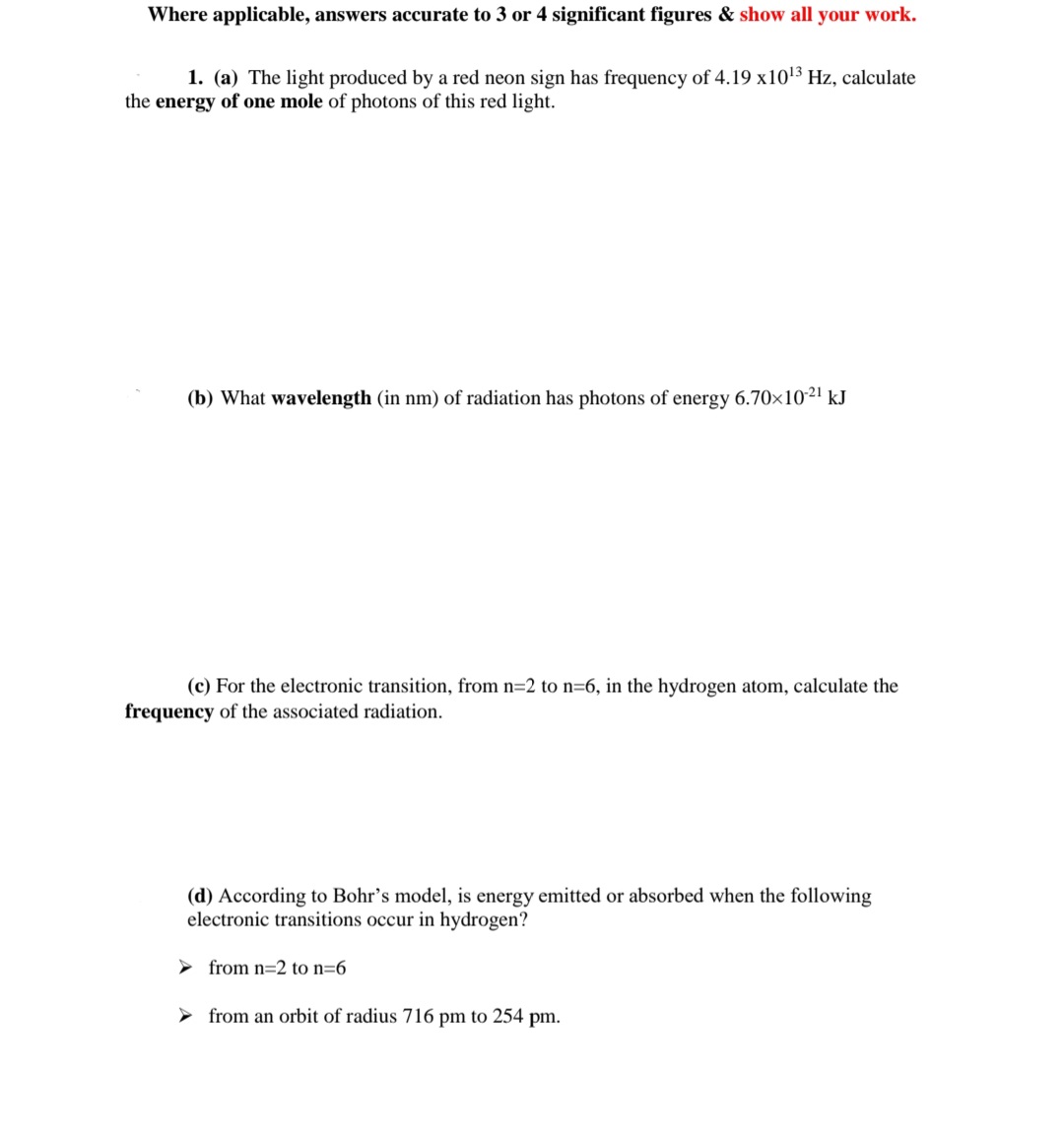Where applicable, answers accurate to 3 or 4 significant figures & show all your work. 1. (a) The light produced by a red neon sign has frequency of 4.19 x1013 Hz, calculate the energy of one mole of photons of this red light. (b) What wavelength (in nm) of radiation has photons of energy 6.70x1021 kJ (c) For the electronic transition, from n=2 to n=6, in the hydrogen atom, calculate the frequency of the associated radiation.
Where applicable, answers accurate to 3 or 4 significant figures & show all your work. 1. (a) The light produced by a red neon sign has frequency of 4.19 x1013 Hz, calculate the energy of one mole of photons of this red light. (b) What wavelength (in nm) of radiation has photons of energy 6.70x1021 kJ (c) For the electronic transition, from n=2 to n=6, in the hydrogen atom, calculate the frequency of the associated radiation.
Chemistry: Principles and Reactions
8th Edition
ISBN:9781305079373
Author:William L. Masterton, Cecile N. Hurley
Publisher:William L. Masterton, Cecile N. Hurley
Chapter6: Electronic Structure And The Periodic Table
Section: Chapter Questions
Problem 63QAP: A carbon dioxide laser produces radiation of wavelength 10.6 micrometers (1micrometer=106meter)....
Related questions
Question

Transcribed Image Text:Where applicable, answers accurate to 3 or 4 significant figures & show all your work.
1. (a) The light produced by a red neon sign has frequency of 4.19 x1013 Hz, calculate
the energy of one mole of photons of this red light.
(b) What wavelength (in nm) of radiation has photons of energy 6.70×10-2' kJ
(c) For the electronic transition, from n=2 to n=6, in the hydrogen atom, calculate the
frequency of the associated radiation.
(d) According to Bohr's model, is energy emitted or absorbed when the following
electronic transitions occur in hydrogen?
> from n=2 to n=6
> from an orbit of radius 716 pm to 254 pm.
Expert Solution
This question has been solved!
Explore an expertly crafted, step-by-step solution for a thorough understanding of key concepts.
This is a popular solution!
Trending now
This is a popular solution!
Step by step
Solved in 4 steps

Knowledge Booster
Learn more about
Need a deep-dive on the concept behind this application? Look no further. Learn more about this topic, chemistry and related others by exploring similar questions and additional content below.Recommended textbooks for you

Chemistry: Principles and Reactions
Chemistry
ISBN:
9781305079373
Author:
William L. Masterton, Cecile N. Hurley
Publisher:
Cengage Learning

Chemistry: The Molecular Science
Chemistry
ISBN:
9781285199047
Author:
John W. Moore, Conrad L. Stanitski
Publisher:
Cengage Learning


Chemistry: Principles and Reactions
Chemistry
ISBN:
9781305079373
Author:
William L. Masterton, Cecile N. Hurley
Publisher:
Cengage Learning

Chemistry: The Molecular Science
Chemistry
ISBN:
9781285199047
Author:
John W. Moore, Conrad L. Stanitski
Publisher:
Cengage Learning


Principles of Modern Chemistry
Chemistry
ISBN:
9781305079113
Author:
David W. Oxtoby, H. Pat Gillis, Laurie J. Butler
Publisher:
Cengage Learning

Chemistry: An Atoms First Approach
Chemistry
ISBN:
9781305079243
Author:
Steven S. Zumdahl, Susan A. Zumdahl
Publisher:
Cengage Learning
